Raising Water Consciousness through
World’s Biggest Photo Exhibition and
Largest collection of Photo Stories on Water
Photo Stories | Water Leaders
Rajendra Singh: The Waterman of India
Nandita Singh and Om Prakash Singh
5 November, 2017
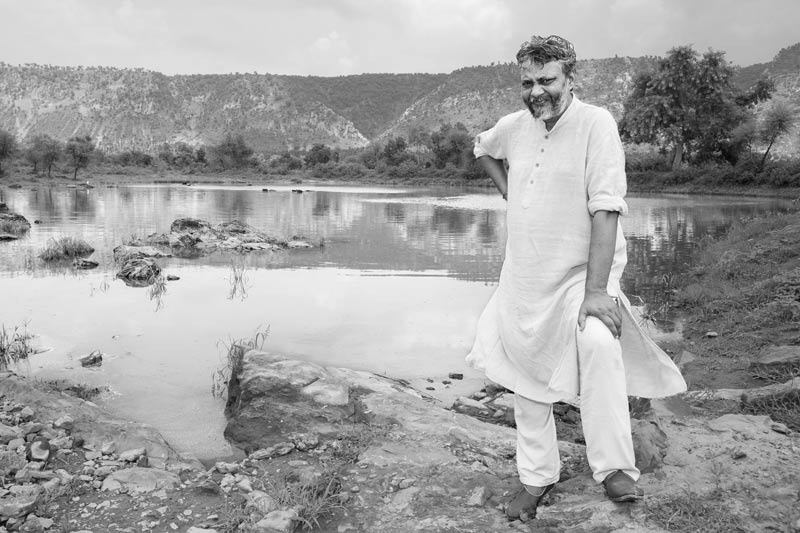
Rajendra Singh, also popularly referred to as the “Waterman of India”, is a well-known water conservationist who is widely credited with bringing water security in the parched lands of Alwar District and adjoining areas of Rajasthan through the traditional wisdom of rainwater harvesting (RWH) based on a community-driven decentralized approach. Under his active leadership, the NGO Tarun Bharat Sangh (TBS) has since 1985 pioneered initiatives to build more than 11,600 community-designed and maintained rainwater water harvesting structures (RWHSs) in over 1,200 villages in 19 districts of the state, covering an area of over 6,500 sq. km. Rajendra Singh started working with water conservation in Alwar district when upon his arrival there for social upliftment of the rural poor, he learnt that the cause of all misery was actually water scarcity. The traditional RWHSs that used to recharge wells and enable villagers to withstand even few years of droughtwere lying derelict and the water table was very deep, degrading village ecosystems and economies. This led him to start rejuvenation of the old RWHSs at the advice of an old villager in Gopalpura, a village in the upper catchment of river Sarsa. This initiative soon yielded results, motivating neighboring villages to follow suit, helping not only ‘catch the rain’ for surface water access but more importantly to recharge groundwater, restore soil moisture and revive the ecology. In order to make it a community-driven effort, through TBS he mobilized people to form Gram Sabhas for collective decision making, designing, construction and management of the RWHSs, using locally available resources and community labor. Through structures like johad, anicut and bandh, rainwater is first conserved, and then made to “flow slow”, allowing it be not only retained as surface water but also to percolate into the ground to replenish the underground aquifers. Through this work not only dry wells and handpumps have been recharged but even 5 dried up rivers namely, Arvari, Sarsa, Bhagani-Tildeh, Jahajwali and Ruparel have come back to life. All these efforts have helped improve agriculture, expand animal husbandry, increase forest resources, and release women and children from the drudgery of carrying water from great distances, bringing about overall development and prosperity in the region. Rajendra Singh’s community-driven water conservation efforts in Rajasthan have earned him several accolades within the country and abroad. Among the several prestigious awards received are included the Asia-wide Ramon Magsaysay Award in 2001 and the international Stockholm Water Prize (also known as the alternate ‘Noble Prize for Water’) in 2015. This is the first ever comprehensive photo story that attempts to portray the principles, actions, outcomes and learnings from the spectacular water conservation work initiated by Rajendra Singh. The title photo depicts the ‘Waterman of India’ Rajendra Singh standing in front of Chountrawala Johad - the first johad in village Gopalpura where he started the work, rejuvenating it together with the villagers in 1985.
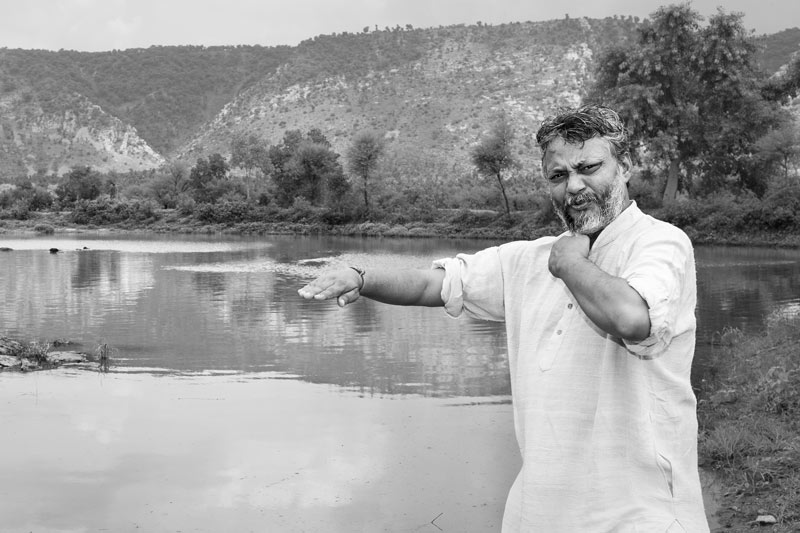
Rajendra Singh explaining the design and principles of a johad at the Chountrawala Johad in Gopalpura village, district Alwar, Rajasthan
Johad is a RWHS constructed at the foothills or on a slope that helps catch and hold the runoff and store it for the dry season to come. It generally consists of a crescent-shaped bund made of earth and/or rocks on three sides towards the lower end while the fourth side on the higher end is left open to allow the runoff to flow in. It serves two functions, first, on the surface it holds water for livestock, and second, more importantly, by holding water in place, it allows the water to percolate down through the soil, recharging the aquifer below. Stored underground, the water is not lost to evaporation, and in the midst of the dry season, allows villagers access to plenty of water from wells, for drinking and irrigating fields. Gopalpura is one of the 52 villages located in the upper end of the catchment of Sarsa river where between 1985 and 1996, under the leadership of Rajendra Singh, the villagers have built 9 johads that cover an area of approx. 10 sq. km. and hold 737 million liters of water.
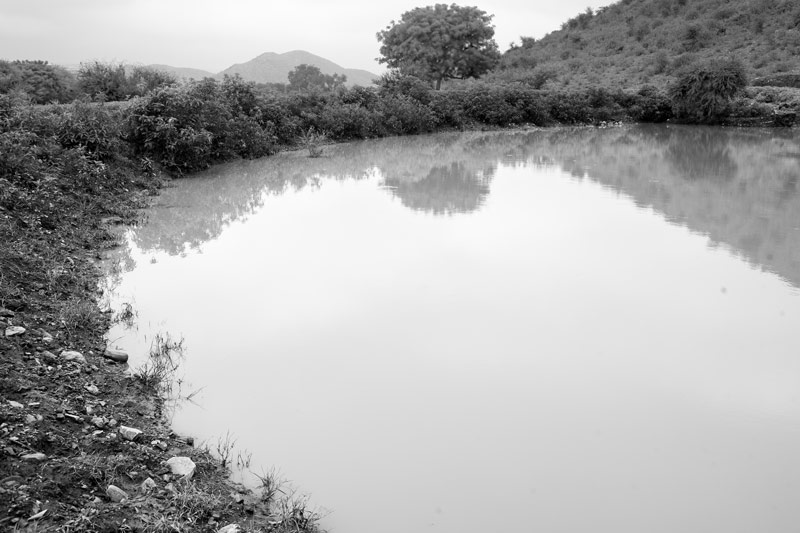
A view of a crescent-shaped johad in village Sada ka Guwara, district Alwar, Rajasthan
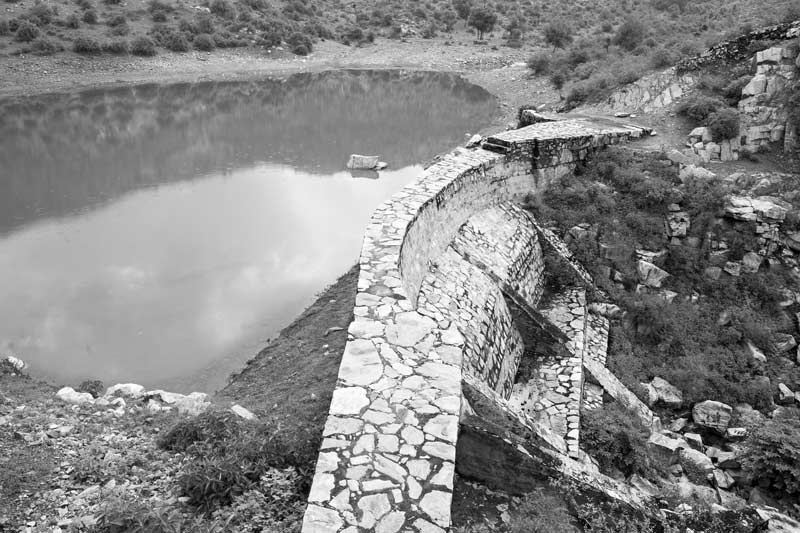
Sankara Wala Bandh in Bhaonta-Kolyala village, district Alwar, Rajasthan
A bandh is an embankment which could be earthen or even be partly concrete, with a height of 1-3 m or sometimes more, built on a stream or water channel to impound and store rainwater. Sankara Wala Bandh is a 244 m long and 7 m high concrete dam situated in the upper catchment of Arvari river, constructed by the villagers under the guidance of Rajendra Singh. This is supposedly the smallest dam in the country made by people themselves, mobilizing their own monetary and labor resources and largely using locally available material, in collaboration with Rajendra Singh’s NGO TBS. The construction of Sankara Wala Bandh was started in 1990 and it took about 5 years to be completed. It is said that when the villagers started the construction, it was perhaps not known that the site was the origin of Arvari river, and by catching and percolating water, they were injecting life back into the dead river.
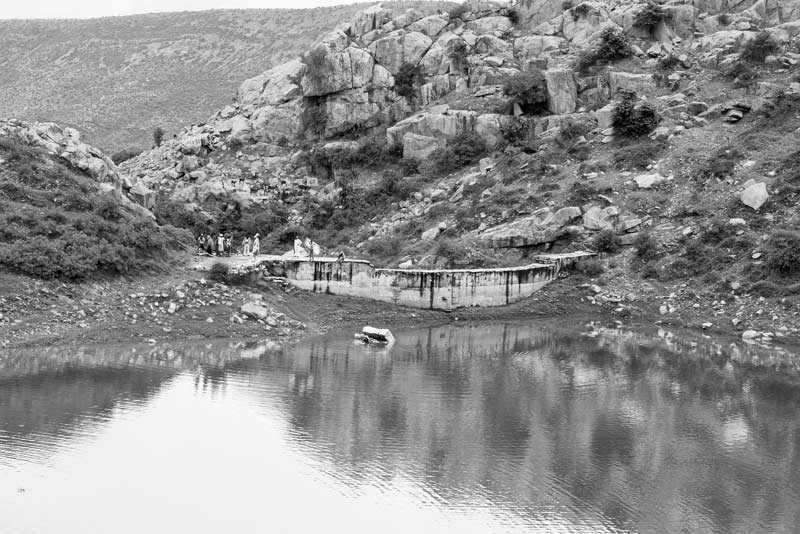
A view of the area of the reservoir behind the Sankara Wala Bandh in village Bhaonta-Kolyala, district Alwar, Rajasthan
The reservoir of the Sankara Wala Bandh is quite large with a maximum storage area of 2.9 ha, a maximum storage depth of 8 m, and an approx. capacity of storing 23,400 liters of water. The size of the catchment is also quite large at about 200 ha.
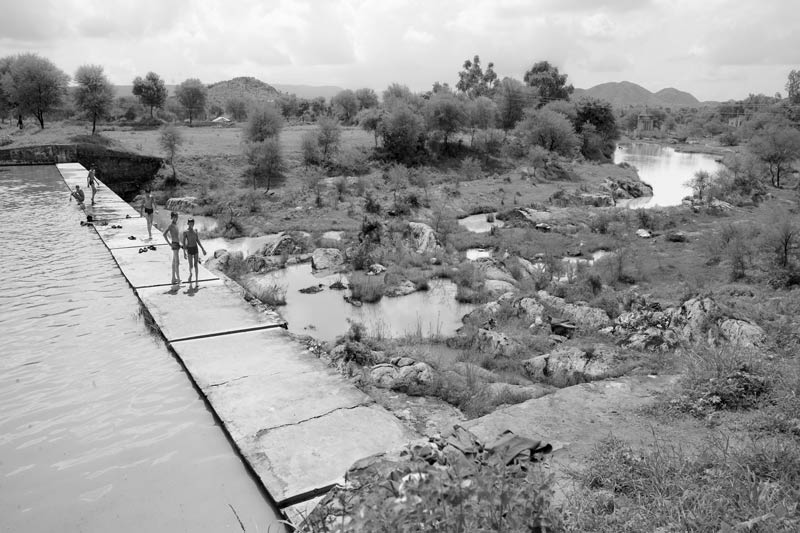
Arvari river with an anicut constructed in its course at village Hamirpur, district Alwar, Rajasthan
Arvari is a river in Alwar district which was regarded as a myth by youngsters in the villages in its catchment because it had remained dry for almost 60 years. However, after RWH initiatives by the village communities in the catchment under Rajendra Singh’s guidance, starting in 1986, the river has slowly come back to life. These RWHSs include the Sankara Wala Bandh, and several johads, anicuts and other structures all along the course of the river and its catchment. In fact, starting in 1995 after 375 RWHSs were completed in the catchment, the river began flowing all year long. The anicut at Hamirpur shown in this photo is one of these structures.
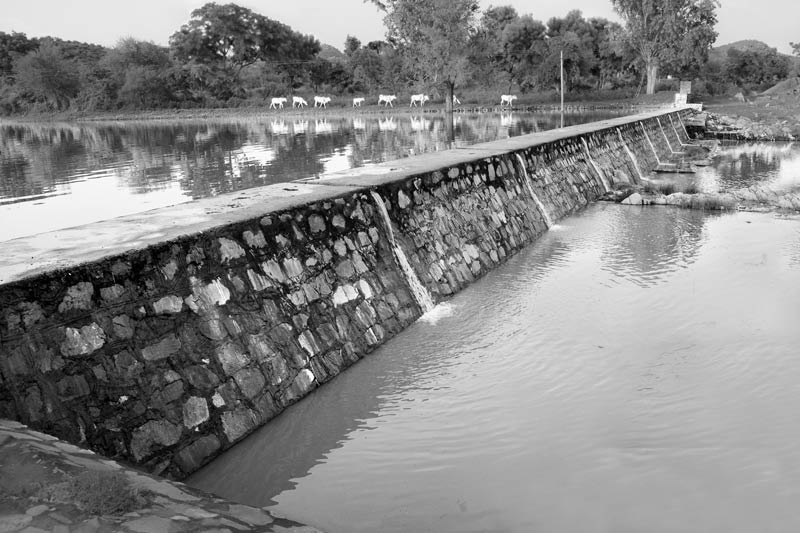
Anicut on Arvari river in the downstream near village Kaler in district Alwar, Rajasthan
A RWHS built of cement and stone (or concrete) that helps intercept the water flowing down a local catchment and hold it for optimum utilization is known as ‘anicut’ in Rajasthan and in other areas of the country as a masonry "check dam". It is generally low in height and permits the water to pass over the structure. A number of anicuts have been constructed under Rajendra Singh’s guidance on river Arvari and other rivers and channels in the area. Anicuts serve multiple purposes by not only reducing the erosive velocity of the runoff but also holding water on the upstream, retaining the surface water flow which can be utilized for different purposes by people and animals. More importantly, the retained water helps recharging the aquifer below, ensuring water in the wells downstream even during the dry season.
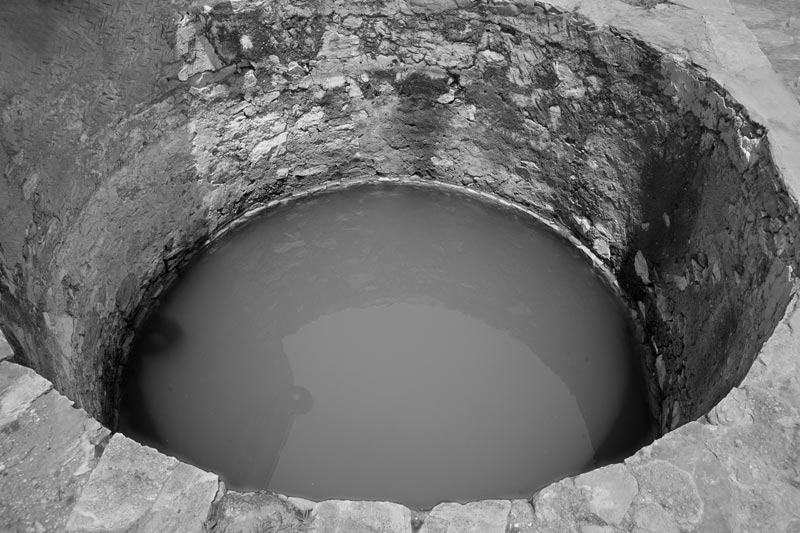
A well filled with water in village Sanwatsar in district Alwar, Rajasthan
The rejuvenation and construction of different kinds of RWHSs has led to large-scale groundwater recharge in the area, which is most evident in the rising water level visible in the village wells. Wells that had turned completely dry in the pre-water conservation times are now filled with water. The groundwater table in Gopalpura and neighboring villages has risen from a depth of over 14 meters below the surface to less than 7 meters, and all wells in the area have water. The ascending aquifer has facilitated drinking water access and enabled the village economies to grow since water is now available for agriculture, animal husbandry and other livelihood options.
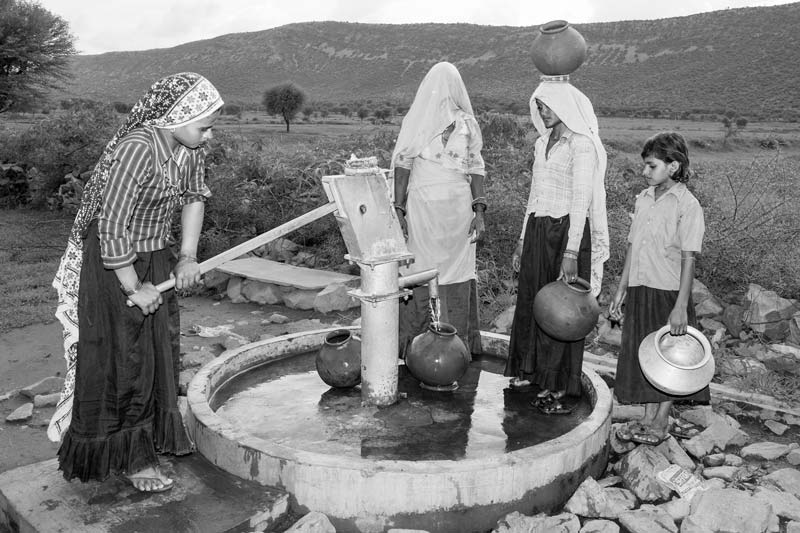
A handpump yielding safe drinking water round the year in Bhaonta-Koylala village, district Alwar, Rajasthan
Due to groundwater recharge through the RWHSs, handpumps and other drinking water sources in the area have water security throughout the year. During the drought of 1985-1988, almost all wells in village Gopalpura had dried up, leading to shortage of drinking water. However, as the water table rose, the drinking water started becoming available. Now, a large number of handpumps in this and other villages in the area provide access to clean and safe water round the year. While women and children as the primary domestic water managers earlier used to spend 5-7 hours each day in pursuit of drinking water, now this takes barely 5-10 minutes. This improves their health and enables children to attend school and later continue higher education. Women increasingly invest their saved time in economic and social pursuits at household and community levels.
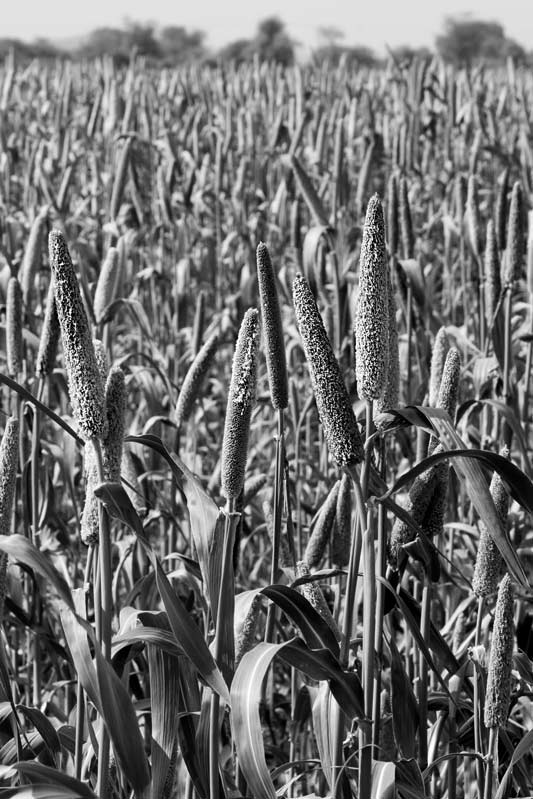
A crop of bajra standing in the fields in village Gopalpura, district Alwar, Rajasthan
Bajra (pearl millet) is a common kharif (rainy season) crop grown in this area but its productivity had become limited due to persistent drought conditions and aridification. As a result of the community-driven water conservation efforts spearheaded by Rajendra Singh, aridification has been reversed and there is increase in soil moisture. Increase in groundwater reserves has also enabled irrigated agriculture on previously un‐irrigated or inadequately irrigated fields. In some villages, reports of wastelands being converted into agricultural lands are also reported. All this has helped multiply the productivity of bajra and other kharif crops manifold. Also, the expense of diesel fuel is reported to have dropped drastically in the area because of higher water table, in Gopalpura the reduction being upto 75%.
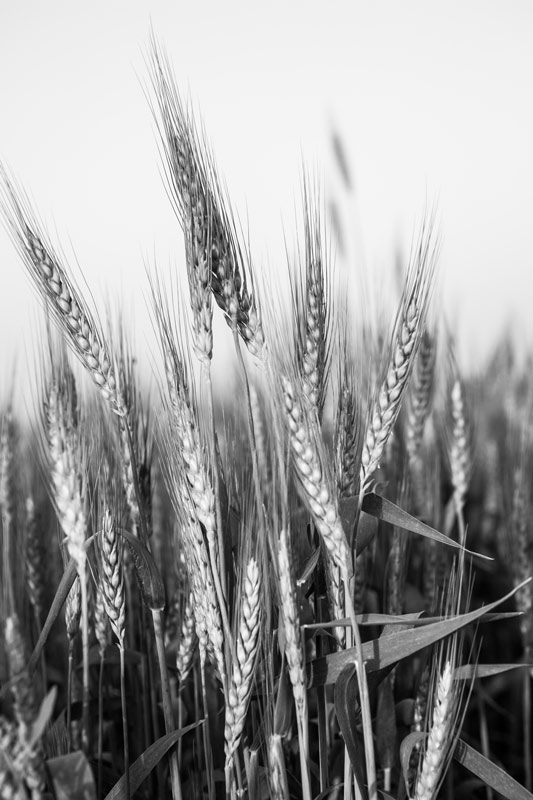
Wheat crop in the fields during rabi season in Gopalpura village, district Alwar, Rajasthan
Apart from improving kharif crop production, RWH has enabled a shift from one-crop to a double-cropping pattern. Before the water conservation works were undertaken in the area, only one kharif crop, generally bajra or maize, was grown as a rainfed crop. With enhanced soil moisture and water for irrigation available in the wells, now a second crop of wheat, mustard or gram is being increasingly grown in the rabi (winter) season in many villages. Even the average productivity of wheat has increased from 720 kg per acre to 1,500 kg per acre due to enhanced moisture availability in the fields. In Gopalpura village, the area under wheat fields is reported to have increased from about 82 acres to about 267 acres, and some farmers have diversified into potatoes and onions.
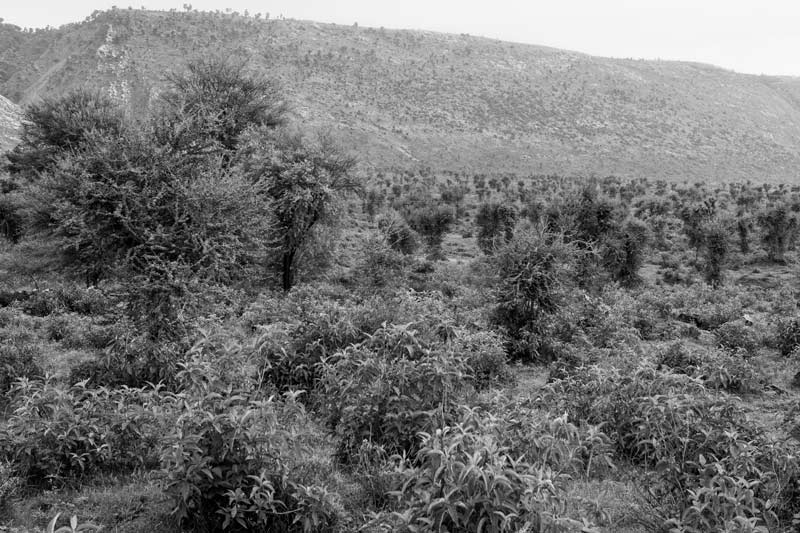
An afforested patch raised by villagers in Gopalpura, district Alwar, Rajasthan
After restoring water, the residents of Gopalpura ardently followed Rajendra Singh’s teaching that “The father of water is the tree and the mother of water is the forest. So if your father and mother are not healthy, the children will not be healthy either”. So, with participation from every family, they successfully reforested 10 hectares along the edge of the village in order to ensure the health of their rejuvenated water resources. Further, for protecting the forest from misuse and overuse, they have framed community rules which allow villagers to break off only dead branches for firewood, but green ones cannot be cut for fodder or any purpose. A fine of 11 rupees is imposed if anyone is caught cutting green branches. Any witness who fails to report a violation is also liable to be fined. Afforestation is practiced in many other villages as well.
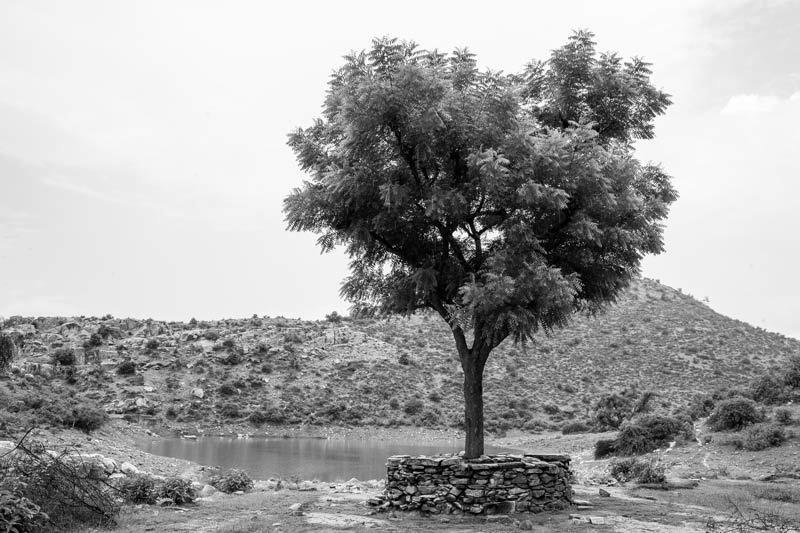
A historical neem tree in the Bhairon Dev public sanctuary in Bhaonta-Koylala village, district Alwar, Rajasthan
In Bhaonta-Koylala village, the residents have reforested about 12 sq. km. of the village area which includes the Sankara Wala Bandh, its catchment, the forest and nearby hills. It has been declared by them as a public wildlife sanctuary called "Bhairon Dev Lok Van Abhayaranya", the first of its kind in the country, being created, recognized and managed by the local community all on its own. Named after the local deity Bhairon Dev, it protects local flora and provides habitat for fauna including birds and mammals like sambar (deer), nilgai (antelope), porcupine, jackal and even leopard. More importantly, presence of the flora is seen as important for water conservation since it helps check soil erosion, preserves sub-soil moisture, and slows down the speed of the runoff during the rainy season. For its ardent efforts at conservation of water and forest, the village received the Joseph C. John award for India's best environmental community from the President of India who visited the village to present the award in 2000. Later their works were visited by Prince Charles in 2003. The village has also been visited by the Parliamentary Committee on Environment who sat for two hours under the Neem tree shown above in the photo. The committee discussed on the community perspectives and their role in conservation and protection of water and forest.
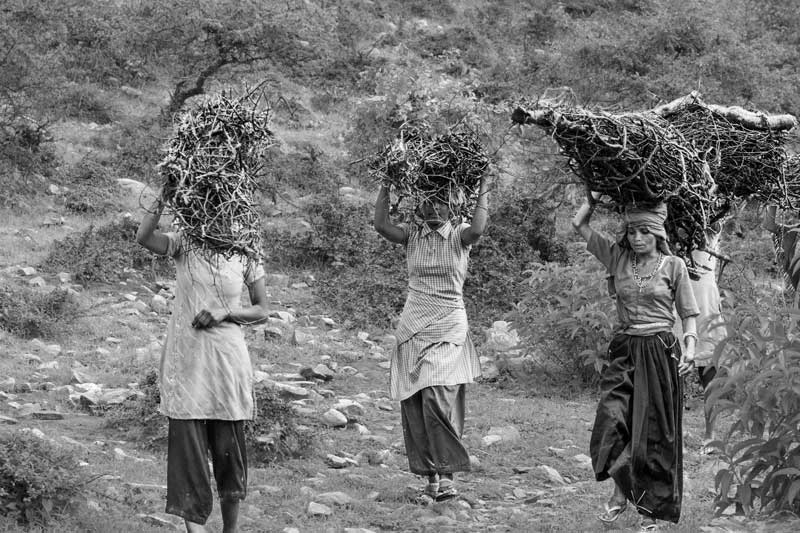
Fetching firewood from the Bhairon Dev public sanctuary in Bhaonta–Koylala village, district Alwar, Rajasthan
Afforestation and restoration of the forest in the Bhairon Dev public sanctuary has improved firewood accessibility for the village women. They can now collect a part of their domestic firewood requirement from the forest. A balance between fulfilling the human needs and the needs of nature is maintained by the community by strictly following self-determined and self-administered rules. According to these rules, only dry branches can be collected for firewood, green branches and trees cannot be cut for this purpose.
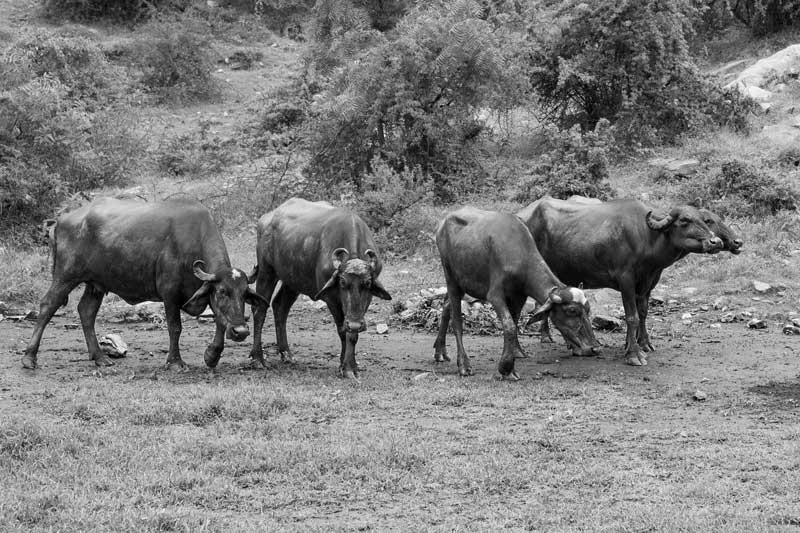
Buffaloes grazing in Bhairon Dev public sanctuary in Bhaonta-Koylala village, district Alwar, Rajasthan
As a result of the water conservation works initiated by Rajendra Singh in the Arvari and other river basins, availability of grazing lands, fodder and water for the livestock has increased, leading to increase in the animal wealth. In the Bhairon Dev public sanctuary, buffaloes, cows and goats are allowed to graze but greenery of the forest is not permitted to be cut for fodder purposes. As a result of the improved fodder and water situation for the livestock, in many villages in the area, the real annual income from animal husbandry per family has risen by an impressive three times.
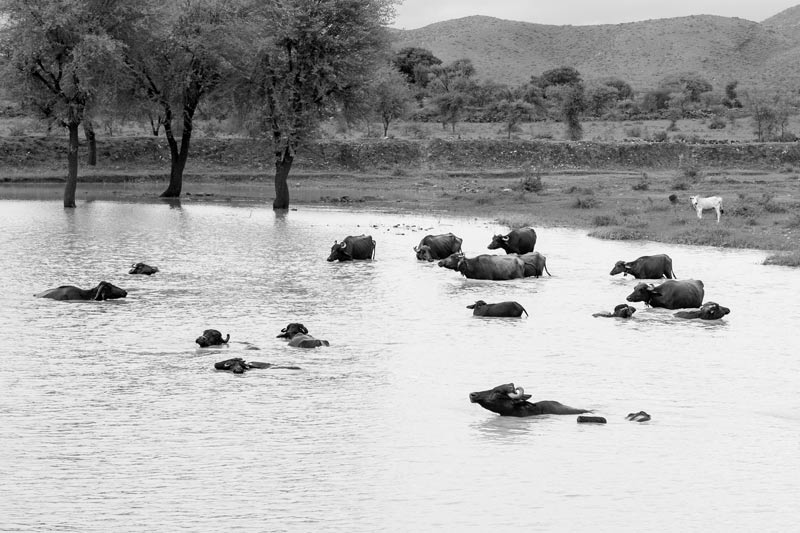
Buffaloes wallowing in a johad in Gopalpura village, district Alwar, Rajasthan
Buffalo is a livestock animal which requires plenty of water for survival. These not only require water for drinking, but also need standing water for wallowing which is essential for regulation of their body temperatures especially during the hot season. Before 1985, maintaining buffalo herds was difficult because of drying up of surface water bodies in the area. However, after initiation of the RWH works, a large number of johads have been created or rejuvenated, which makes surface water availability in plenty even during the hot and dry season. As a result buffaloes are being increasingly integrated into animal herds in the villages, leading to greater milk production. In village Gopalpura, total milk production is said to have risen up to 10 times.
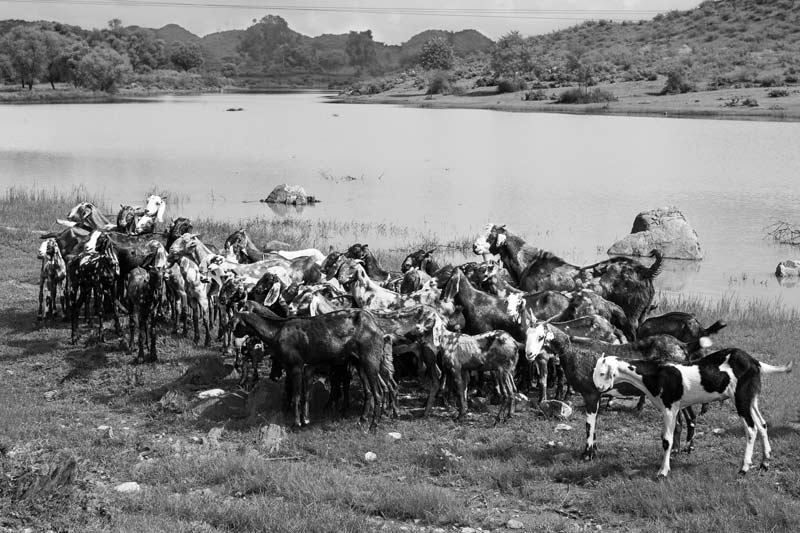
Goats grazing in Kaler village, district Alwar, Rajasthan
As a result of the RWH works, there is increased drinking water availability for animals within forest patches as well as grazing lands in the area, even during peak summers. Also, the availability of grass and greenery in the forest patches and grazing lands has improved due to enhanced soil moisture. Consequently, animals including goats, cows and buffaloes can graze outside round the year, helping proliferation of animal husbandry as a livelihood option.
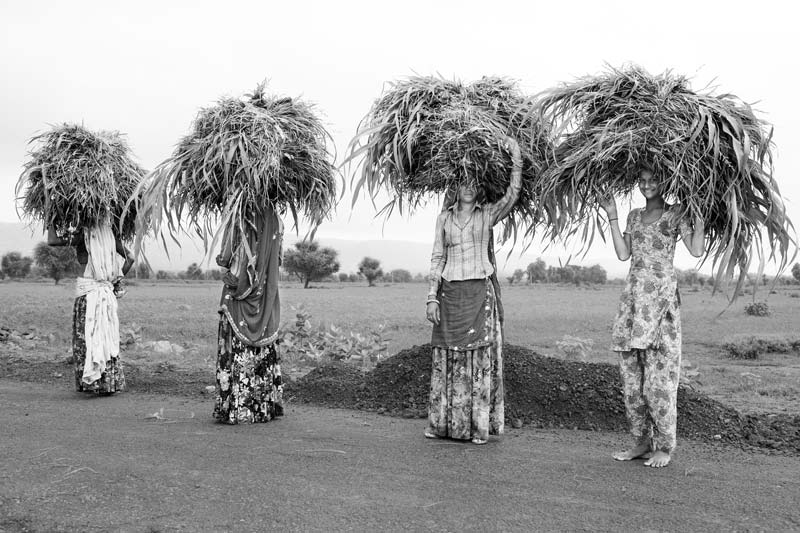
Women fetching green fodder for their animals from the fields in Bheekampura village, district Alwar, Rajasthan
In villages where a significant recharge of wells has taken place, irrigation has led to a positive impact on fodder availability from agriculture lands in the form of agricultural residue from Bajra, maize and wheat as well as cultivation of green fodder. These improvements have led to increased milk yields, with a consequent increase in incomes from the animal husbandry sector.
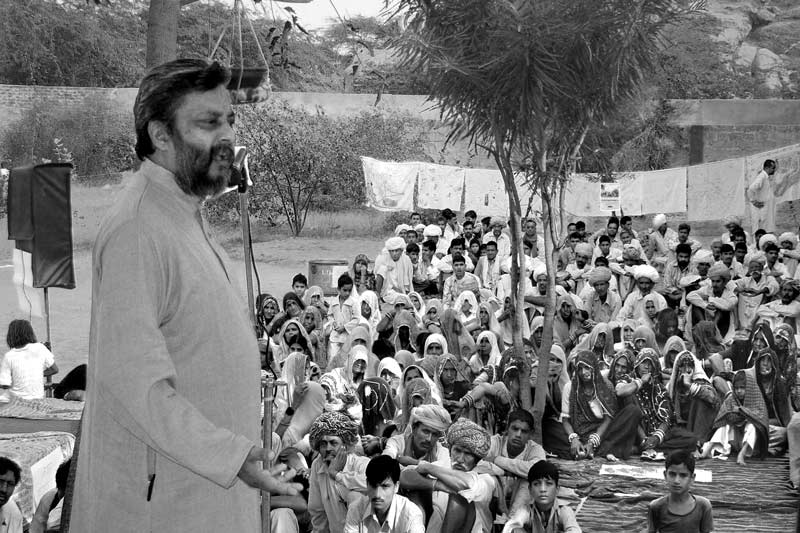
Rajendra Singh addressing a public meeting in a village in Jaipur district, Rajasthan
The ‘Water Man of India’ has taken upon himself the responsibility of spreading messages based on traditional water wisdom far and wide in the state and the country. He organizes and participates in rooted water awareness campaigns, helping communities learn to conserve, protect and develop their own water and environmental resources through community-driven decentralized water management efforts. He has also addressed many national and international forums and is a member of several Government and UN Committees and delegations. In recent years he has been engaged in spreading the messages of water conservation, sustainability, and harmony of water, man and nature across the world. Since 2015 he is also engaged in World Water Peace Walks in an attempt to foster water as an instrument of world peace rather than war.
From the above photo story it emerges that the water conservation interventions spearheaded by Rajendra Singh in Rajasthan represent a spectacular effort at practicing integrated water resources management (IWRM) within local river basins that have uniquely contributed to the reversal of cycles of aridification, ecosystem degradation and consequent human impoverishment and depopulation. The interventions have proved to be a robust adaptation strategy for addressing climatic uncertainties and disasters (including drought) in over a thousand of semi-arid villages as evidenced by the greenery, increasing agricultural productivity and livestock wealth. The impounding of just 3% of the rainfall has brought about the economic and ecological miracle of regeneration, turning the region from “dark” to “white” zone in terms of groundwater availability. The area under single cropping has increased from 11% to 70% out of which the area under double cropping has increased from 3% to 50%, bringing prosperity to the farmers. The forest cover, which used to be around 7% increased to 40%, providing sufficient fuel wood and sequestering carbon from atmosphere. Eearlier women had to walk over 3-5 km just to fetch water but now there is water for domestic use inside the villages, leading to saving of time upto 6-7 hours every day. This has enabled women’s socio-economic empowerment and children’s education. The availability of fuelwood has improved significantly and planting of ‘dev banis’ (sacred groves), an old village tradition, has been revived, influencing the microclimate beneficially. Rajendra Singh’s water conservation endeavors and their success offer a number of significant learnings for not only India but also the world. First, sustainable development of society is rooted in water security which is possible through IWRM, further based on the traditional wisdom of RWH. A central principle in the RWH approach promoted by Rajendra Singh is ‘flow slow’ which aims at reducing the speed of the runoff through construction of RWHSs and afforestation. Second, for ensuring inclusive growth and economic stability, the IWRM approach needs to be rooted in ‘integration’ at two levels: integration of communities in a basin and that of water with other components of the ecosystem (e.g. forest). Third, sustainability of the efforts at enhancing water security must be rooted in a community-driven decentralized water management and governance approach with dependence on traditional knowledge, locally available technology and local resources. Fourth, RWH is a robust tool that has the potential of not only recharging groundwater but even rejuvenation of rivers. Therefore, water conservation and RWH must be promoted and scaled-up for restoring river flows and rejuvenating other depleted surface water bodies. Finally, traditional RWH-based IWRM must not only be seen as an approach for gaining water security but also be adopted as a robust measure for securing adaptation to climate change impacts on water. According to Rajendra Singh, the main cause of water insecurity, water stress and scarcity in the changing world is the undisciplined use of water. He says that at present globally there is emphasis on the practice of only 3 R’s—reduce, reuse and recycle, but there is need to incorporate 3 more R’s from traditional Indian water wisdom, namely Respect, Retreat and Rejuvenate (the source). Adoption of the 6 R’s as a part of the traditional RWH-based IWRM model can undoubtedly support local and thereby global efforts towards reaching the Sustainable Development Goals (SDGs) and protect, promote and secure the human rights of millions of women, men and children to water, health, environment, education and other rights in a world exposed to threats posed by water stress and climatic uncertainties.